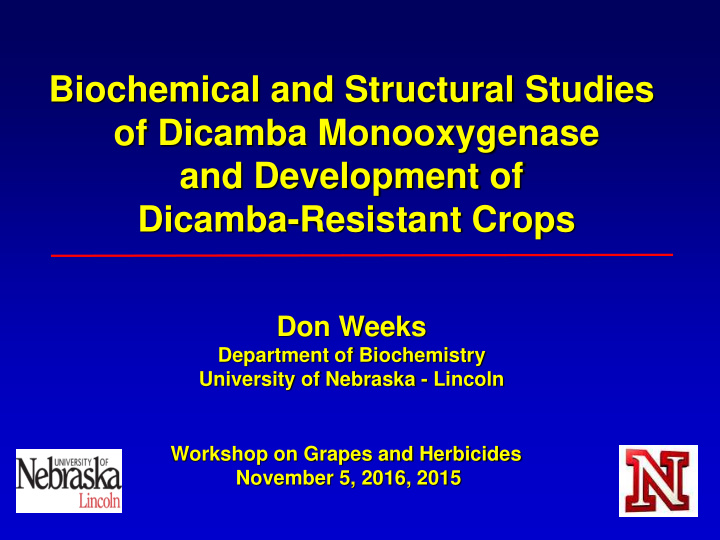



Biochemical and Structural Studies of Dicamba Monooxygenase and Development of Dicamba-Resistant Crops Don Weeks Department of Biochemistry University of Nebraska - Lincoln Workshop on Grapes and Herbicides November 5, 2016, 2015
Dicamba COOH Cl OCH 3 Cl An Auxin-type Herbicide Mimics the plant hormone, Indoleacetic Acid (IAA) Too Much Hormone Kills Plants Broadleaf (Dicot) Plants are More Sensitive Than Grassy (Monocot) plants
Dicamba COOH Cl OCH 3 Cl Uses: Dicamba is used to control broadleaf weeds (dicots) in grass-type crops (monocots). Until now, all broadleaf crops were sensitive to treatment with dicamba. Goal: Convert sensitive broadleaf crops (soybeans, cotton, vegetables) into dicamba-tolerant crops. Strategy: Place a gene in sensitive crops that produces an enzyme capable of inactivating dicamba.
Strategy: 1. Find bacterium with dicamba degrading enzyme 2. Purify the enzyme to homogeneity 3. Obtain N-terminal amino acid sequence 4. Design “ degenerate ” oligonucleotide probes 5. Use probes to select target gene 6. Genetically engineer gene to be a plant gene 7. Produce transgenic plants expressing the gene 8. Spray plants with dicamba - Hope for the best
Dicamba Degrading Bacterium: Stenotrophomonas maltophilia, strain DI6 • Utilizes Dicamba as a Sole Carbon and Energy Source Dicamba O-demethylase COOH COOH Cl Cl CO 2 OCH 3 OH H 2 O Cl Cl Cl - Dicamba DCSA • First Step in Degradation Inactivates Dicamba
But wait! Life is not so simple! Dicamba O-demethylase is not a single enzyme It is 3 separate enzymes working together in a chain reaction: A reductase A ferredoxin A monooxygenase Dicamba Monooxygenase (DMO)
Dicamba O-Demethylase is a Three Component Enzyme System NAD+ NADH + H + Oxidized (Flavin) Reductase Reduced (Flavin) (Fe +3 ; 2Fe:2S) Ferredoxin (Fe +2 ) (Fe +3 ) (Fe +2 ; 2Fe:2S) Oxygenase O 2 + Dicamba DCSA + H 2 CO + H 2 O
Crystals of DMO
Dicamba Monooxygenase Active site: Dicamba Oxidation
Dicamba Oxidation Reaction
Can DMO Provide Dicamba Resistance in Transgenic Plants? Genetic Engineering of the Bacterial DMO Gene into a Plant DMO Gene
Dicamba O-Demethylase is a Three Component Enzyme System NAD+ NADH + H + Reductase Oxidized (Flavin) Reduced (Flavin) (Fe +3 ; 2Fe:2S) * (Fe +2 ) Ferredoxin (Fe +3 ) (Fe +2 ; 2Fe:2S) Oxygenase O 2 + Dicamba DCSA + H 2 CO + H 2 O *Bacterial Ferredoxin ~ Chloroplast Ferredoxin
Target DMO to the Chloroplast The Bacterial Ferredoxin is Quite Similar in Structure to Plant Chloroplast Ferredoxin Target DMO to the Chloroplast where there is an Abundance of Ferredoxin If Successful, Only the Single DMO Gene will be Needed in Transgenic Plants
Genetically Engineering the DMO Gene for Strong Expression in Plants Turning a Bacterial Gene into a Plant Gene Bacterial Gene Promoter Bacterial Gene Termination Signal An “ On/Off ” Switch XhoI NcoI NcoI EcoRI XbaI ClaI 465 bp 1020 bp 654 bp 140 bp 256 bp Terminator Plant Gene DMO Gene (TEV) Promoter (rbcS3 ’ ) Chloroplast (PCISVFLt36) Transit Peptide Plant Gene Promoter Plant Gene Termination Signal Strong “ On ”
Concentration-dependent Sensitivity to Dicamba 0 0.0156 0.031 0.062 0.125 0.25 0.5 Recommended Rates Conc. of Dicamba (lb/acre)
Test for Dicamba Resistance Transgenic Control Top view Dicamba @ 5.6 kg/ha (5.0 lb/A) 10-20 X Recommended Rate
Decreased Sensitivity to Dicamba in Tobacco Wild-type Plants Sensitive to 0.001 lb/acre Nuclear Genome Transformants Resistant to >25 lb/acre Chloroplast Genome Transformants Resistant to >50 lb/acre > 25,000X Decrease in Sensitivity
Soybean Field Trials Summer 2005 Nontransgenic Dicamba Resistant Soybean Plants Soybean Plants Dicamba resistance gene technology licensed to Monsanto Important in controlling tough glyphosate-resistant weeds
Glyphosate-resistant Weeds - A major Economic Problem HoosierAgToday Soybean Field with Glyphosate-resistant Marestail Dicamba Kills Most Glyphosate-resistant Broadleaf Weeds
Dicamba-Tolerant Soybeans Expected to Provide the Most Effective Weed Management System 2009 Southern Illinois University Trials of Xtend soybean varieties Dicamba mixed with Roundup on Non-treated RR2Y /dicamba-tolerant soybeans Control Roundup plus dicamba provides excellent control of hard to control weeds and glyphosate-tolerant weeds Monsanto Commercialization Began In 2016
Three Herbicide Options Would Expand Weed Control Choices For Farmers 2009 U.S. Field Trials Jerseyville, Illinois – June 2009 Herbicide- Wild Type Wild Type Herbicide- Tolerant Control Control Tolerant Events Events Wild Type vs. Herbicide Tolerant Event Wild Type vs. Herbicide Tolerant Event Glufosinate 1.28 lb.@ V7 Glyphosate 3 lbs. plus Dicamba 1 lb.@ V7 • Multiple modes of action expand grower choice and efficacy • Cost effective resistance management Monsanto • Grower efficiency through wider application window
Dicamba-resistant Crops in Development Canola Wheat Sugar Beet Alfalfa Engenia: A lower volatility dicamba formulation Monsanto
Biochemical and Structural Studies of Dicamba Monooxygenase and Development of Dicamba-Resistant Crops Don Weeks Department of Biochemistry University of Nebraska - Lincoln Thank You Questions?
Recommend
More recommend